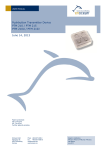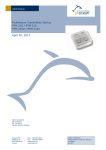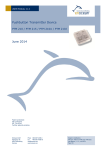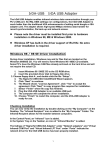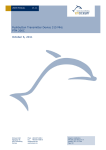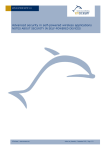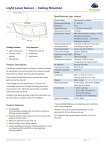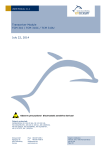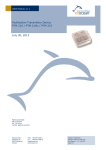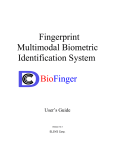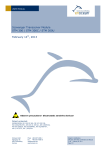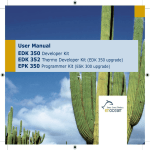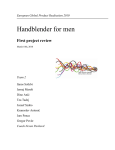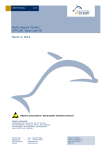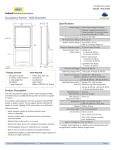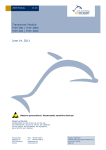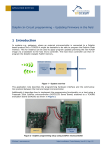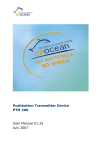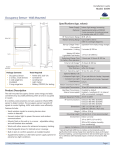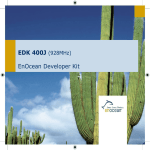Download User Manual: Pushbutton Transmitter Device PTM 210
Transcript
USER MANUAL Pushbutton Transmitter Device PTM 210 / PTM 215 / PTM 210U January 21, 2013 Patent protected: US 6,747,573 US 7,019,241 Further patents pending EnOcean GmbH Kolpingring 18a 82041 Oberhaching Germany Phone +49.89.67 34 689-0 Fax +49.89.67 34 689-50 [email protected] www.enocean.com Subject to modifications PTM 210 / PTM 215 / PTM 21U User Manual January 2013 Page 1/19 USER MANUAL PTM 210 / PTM 215 / PTM 210 U REVISION HISTORY The following major modifications and improvements have been made to the first version of this document: No 1.0 2.0 2.1 Major Changes Updated operating force to typ. 8 N Merged PTM 210, PTM 215 and PTM 210U into one user manual Changed naming “module to device”, image added on first page Published by EnOcean GmbH, Kolpingring 18a, 82041 Oberhaching, Germany www.enocean.com, [email protected], phone ++49 (89) 6734 6890 © EnOcean GmbH All Rights Reserved Important! This information describes the type of component and shall not be considered as assured characteristics. No responsibility is assumed for possible omissions or inaccuracies. Circuitry and specifications are subject to change without notice. For the latest product specifications, refer to the EnOcean website: http://www.enocean.com. As far as patents or other rights of third parties are concerned, liability is only assumed for devices, not for the described applications, processes and circuits. EnOcean does not assume responsibility for use of devices described and limits its liability to the replacement of devices determined to be defective due to workmanship. Devices or systems containing RF components must meet the essential requirements of the local legal authorities. The devices must not be used in any relation with equipment that supports, directly or indirectly, human health or life or with applications that can result in danger for people, animals or real value. Components of the devices are considered and should be disposed of as hazardous waste. Local government regulations are to be observed. Packing: Please use the recycling operators known to you. By agreement we will take packing material back if it is sorted. You must bear the costs of transport. For packing material that is returned to us unsorted or that we are not obliged to accept, we shall have to invoice you for any costs incurred. EnOcean GmbH Kolpingring 18a 82041 Oberhaching Germany Phone +49.89.67 34 689-0 Fax +49.89.67 34 689-50 [email protected] www.enocean.com Subject to modifications PTM 210 / PTM 215 / PTM 21U User Manual January 2013 Page 2/19 USER MANUAL PTM 210 / PTM 215 / PTM 210 U TABLE OF CONTENT 1 1.1 1.2 1.3 1.4 1.5 1.6 2 2.1 2.2 2.3 2.3.1 2.3.2 2.3.3 3 3.1 3.2 3.3 4 4.1 4.2 GENERAL DESCRIPTION .................................................................................... 4 Basic Functionality ........................................................................................... 4 Typical Applications .......................................................................................... 5 Technical Data ................................................................................................. 5 Mechanical Interface ......................................................................................... 6 Environmental Conditions ................................................................................ 11 Ordering Information ...................................................................................... 11 FUNCTIONAL DESCRIPTION ............................................................................. 12 Block Diagram ............................................................................................... 12 Contact Nipples Designation ............................................................................ 13 Operating modes ........................................................................................... 13 Normal mode (PTM 210, PTM 210U, PTM 215) ................................................ 13 Secure mode (PTM 215)............................................................................... 14 Switching between modes ............................................................................ 15 APPLICATIONS INFORMATION ......................................................................... 16 Construction of application specific Switch Rockers ............................................. 16 Device Mounting ............................................................................................ 16 Transmission Range ....................................................................................... 17 AGENCY APPROVALS ...................................................................................... 18 PTM 210 and PTM 215 CE Approval .................................................................. 18 FCC and Industry Canada Regulatory Statements ............................................... 19 EnOcean GmbH Kolpingring 18a 82041 Oberhaching Germany Phone +49.89.67 34 689-0 Fax +49.89.67 34 689-50 [email protected] www.enocean.com Subject to modifications PTM 210 / PTM 215 / PTM 21U User Manual January 2013 Page 3/19 USER MANUAL PTM 210 / PTM 215 / PTM 210 U 1 GENERAL DESCRIPTION The radio transmitter device PTM 21x from EnOcean enables the implementation of wireless remote controls without batteries. Power is provided by a built-in electro-dynamic power generator. The PTM 21x device serves the 868 MHz and 902 MHz radio interface protocol of EnOcean. (1) Energy bow on both device sides (2) Contact nipples for switch rocker identification Rotation axis for pushbuttons or switch rocker Electro-dynamic powered radio transmitter device PTM 21x Following variants are available: PTM 210 868,300 MHz PTM 215 868,300 MHz with encryption PTM 210U 902,875 MHz 1.1 Basic Functionality A common electro-dynamic energy transducer is actuated by a bow (1), which can be pushed from outside the device by an appropriate push button or switch rocker. When the energy bow is pushed down, electrical energy is created and an RF telegram is transmitted including a 32-bit device ID. Releasing the energy bow generates different telegram data, so every PTM telegram contains the information that the bow was pressed or released. “Long” or “Short” push button operation (the time between pushing and releasing the pushbutton) can be easily detected by the receiver. By doing that, applications such as dimming control or blinds control including slat action are simple to implement. EnOcean GmbH Kolpingring 18a 82041 Oberhaching Germany Phone +49.89.67 34 689-0 Fax +49.89.67 34 689-50 [email protected] www.enocean.com Subject to modifications PTM 210 / PTM 215 / PTM 21U User Manual January 2013 Page 4/19 USER MANUAL PTM 210 / PTM 215 / PTM 210 U In addition, the PTM telegram transmits the operating status of the contact nipples (2) when pressing the bow. This enables the identification of up to 2 appropriate switch rockers or up to 4 pushbuttons. PTM 215 supports 2 operating modes. A normal mode and a secure mode with additional rolling code mechanism which allows to prevent replay attacks in sensible applications. 1.2 Typical Applications Building installation Industrial automation Consumer electronics Key applications are wall-mounted flat rocker switches with 1 or 2 rockers, as well as handheld remote controls with up to 4 single pushbuttons. Because the RF transmitters are self-powered (no batteries), maintenance-free RF systems are possible. 1.3 Technical Data Power supply power generation by rocker operating, electro-dynamic power generator Antenna internal PCB antenna Frequency PTM 210: 868.300 MHz (ASK)* PTM 215: 868,300 MHz (ASK)* PTM 210U: 902,875 MHz (FSK) Data rate 125 kbps Channels 2 with 4 action states each upper/lower pushbutton is pressed/released EnOcean Equipment Profile supported Security mode EEP F6-02-xx, F6-04-xx rolling code with AES128 (PTM 215 only) Transmission range Device-identifier typ. 300 m free field, typ. 30 m indoor individual 32-bit ID (factory programmed) *) According the international standard for energy harvesting wireless radio protocol for self-powered applications: ISO/IEC 14543-3-10 EnOcean GmbH Kolpingring 18a 82041 Oberhaching Germany Phone +49.89.67 34 689-0 Fax +49.89.67 34 689-50 [email protected] www.enocean.com Subject to modifications PTM 210 / PTM 215 / PTM 21U User Manual January 2013 Page 5/19 USER MANUAL PTM 210 / PTM 215 / PTM 210 U 1.4 Mechanical Interface Device dimensions (inclusive rotation axis and energy bow) Device weight 40.0 x 40.0 x 11.2 mm 20 g ± 1 g Energy bow travel / operating force 1.8 mm / typ. 8 N *) at room temperature, only one energy bow may be actuated at the same time! Restoring force at energy bow typ. 0.7 N to 4 N For the correct function of the application, the specified minimal restoring force of 0.5 N must be considered! Number of operations at 25°C typ. 100.000 actuations tested according to VDE 0632 / EN 60669 Cover material Hostaform (POM) Energy bow material EnOcean GmbH Kolpingring 18a 82041 Oberhaching Germany Phone +49.89.67 34 689-0 Fax +49.89.67 34 689-50 [email protected] www.enocean.com PBT (50% GV) Subject to modifications PTM 210 / PTM 215 / PTM 21U User Manual January 2013 Page 6/19 USER MANUAL PTM 210 / PTM 215 / PTM 210 U Energy Bow Stopper PTM 21x without antenna, tilted view (including rocker catwalks) 1) these catwalks are not needed when using one single rocker only 2) dimensions of rocker part PTM 21x, top view (note cut A, B and C marking) EnOcean GmbH Kolpingring 18a 82041 Oberhaching Germany Phone +49.89.67 34 689-0 Fax +49.89.67 34 689-50 [email protected] www.enocean.com Subject to modifications PTM 210 / PTM 215 / PTM 21U User Manual January 2013 Page 7/19 USER MANUAL PTM 210 / PTM 215 / PTM 210 U PTM 21x, cut A 2) dimensions of rocker part PTM 21x, cut B and C EnOcean GmbH Kolpingring 18a 82041 Oberhaching Germany Phone +49.89.67 34 689-0 Fax +49.89.67 34 689-50 [email protected] www.enocean.com Subject to modifications PTM 210 / PTM 215 / PTM 21U User Manual January 2013 Page 8/19 USER MANUAL PTM 210 / PTM 215 / PTM 210 U labeling area Hatched areas: support planes PTM 21x rear view EnOcean GmbH Kolpingring 18a 82041 Oberhaching Germany Phone +49.89.67 34 689-0 Fax +49.89.67 34 689-50 [email protected] www.enocean.com Subject to modifications PTM 210 / PTM 215 / PTM 21U User Manual January 2013 Page 9/19 USER MANUAL PTM 210 / PTM 215 / PTM 210 U catwalks of switch rocker rotary rocker tilted to 5.4 degrees (corresponds to 1.8 mm energy bow travel) support plane mounting plane press bow to stopper 2) dimensions of rocker part PTM 21x, side view If the rocker is not mounted on the rotation axis of PTM 21x several tolerances have to be considered! The measure from support plane to top of the energy bow is 7.70 mm +/- 0.3 mm! The movement of the energy bow must not be limited by mounted rockers! Catwalks of switch rocker must not exert continuous forces on contact nipples! EnOcean GmbH Kolpingring 18a 82041 Oberhaching Germany Phone +49.89.67 34 689-0 Fax +49.89.67 34 689-50 [email protected] www.enocean.com Subject to modifications PTM 210 / PTM 215 / PTM 21U User Manual January 2013 Page 10/19 USER MANUAL PTM 210 / PTM 215 / PTM 210 U 1.5 Environmental Conditions Operating temperature -25 °C up to +65 °C Storage temperature -25 °C up to +65 °C Humidity 1.6 0% to 95% r.h. Ordering Information Type PTM 210 PTM 215 PTM 210U EnOcean GmbH Kolpingring 18a 82041 Oberhaching Germany Ordering Code S3001-A210 S3001-A215 S3031-A210 Phone +49.89.67 34 689-0 Fax +49.89.67 34 689-50 [email protected] www.enocean.com Approvals EN300220 EN300220 FCC / IC Subject to modifications PTM 210 / PTM 215 / PTM 21U User Manual January 2013 Page 11/19 USER MANUAL PTM 210 / PTM 215 / PTM 210 U 2 2.1 FUNCTIONAL DESCRIPTION Block Diagram Data Processor HF Contact Nipples Pushed/Released Ant DC Power Energy Bow N S Power Converter Block diagram of PTM 21x Energy Bow / Power Generator Converts pressure on the energy bow into electrical energy. Power Converter Electronic converter unit for generating the device DC power supply Processor Converts the contact nipples’ status and pushed/released data from the power generator into a reliable and energy-efficient telegram structure. Radio transmitter Sends the data in the form of a series of short EnOcean radio telegrams. EnOcean GmbH Kolpingring 18a 82041 Oberhaching Germany Phone +49.89.67 34 689-0 Fax +49.89.67 34 689-50 [email protected] www.enocean.com Subject to modifications PTM 210 / PTM 215 / PTM 21U User Manual January 2013 Page 12/19 USER MANUAL PTM 210 / PTM 215 / PTM 210 U 2.2 Contact Nipples Designation With 4 contact nipples, the PTM 21x offers 2 channels with 4 action states each (upper/lower nipple is pressed/released when activating the energy bow). The nipples’ designation is as follows: STATE O A CHANNEL B I Contact nipple designation 2.3 Operating modes There are 2 operating modes: Normal mode: PTM 210, PTM 210U and PTM 215 Secure mode: PTM 215 After production, PTM 215 is set to “normal mode”. Radio signals of the PTM 21x are event-controlled (energy bow is pressed/released) with contact nipple code (channel/state) and unique device identification (fixed 32-bit ID). 2.3.1 Normal mode (PTM 210, PTM 210U, PTM 215) In normal mode, PTM 21x sends telegrams according to EEP F6-02-xx and F6-04-xx as specified in EnOcean Equipment Profiles V2.1. Details see: http://www.enocean-alliance.org/fileadmin/redaktion/enocean_alliance/pdf/EnOcean_Equipment_Profiles_EEP2.1.pdf Due to the mechanical hysteresis of the energy bow, in most rocker switch device implementations, pressing the rocker sends an N-message and releasing the rocker sends a U-message! EnOcean GmbH Kolpingring 18a 82041 Oberhaching Germany Phone +49.89.67 34 689-0 Fax +49.89.67 34 689-50 [email protected] www.enocean.com Subject to modifications PTM 210 / PTM 215 / PTM 21U User Manual January 2013 Page 13/19 USER MANUAL PTM 210 / PTM 215 / PTM 210 U 2.3.2 Secure mode (PTM 215) In secure mode, PTM 215 sends telegrams with rolling code as specified in the “Security of EnOcean Radio Networks” specification. When telegrams are not received by the receiver this may lead to a de-synchronization of transmitter and receiver. In order to prevent failure, the receiver will usually test if the rolling code is in a defined window and will resynchronize automatically. The size of this rolling code window is set on the receiver side. The teach-in telegram is described in chapter 4.2 of “Security of EnOcean Radio Networks”. Type is: 1-PTM It is sent by simultaneously pressing both contact nipples of rocker A or rocker B and actuating the energy bow. See also 2.3.3. In operating mode the telegram structure is as follows: R-ORG-S 8 bit R-ORG-S DATA DATA 8 bit MAC 24 bit ID 32 bit STATUS 8 bit : 0x30 : This field is encrypted. After decryption with VAES decryption algorithm DATA can be interpreted as shown in the table below. The VAES decryption algorithm is described in the “Security of EnOcean Radio Networks” specification. http://www.enocean.com/en/security-specification/ MAC ID STATUS DATA after decryption with VAES 0x00-0x04 0x05 0x06 0x07 0x08 0x09 0x0A 0x0B 0x0C 0x0D 0x0E 0x0F EnOcean GmbH Kolpingring 18a 82041 Oberhaching Germany DolphinAPI provides functions for this purpose : Message authentication code as described in the “Security of EnOcean Radio Networks” specification. http://www.enocean.com/en/security-specification/ In order to verify if a telegram is valid the receiver has to calculate the MAC based on R-ORG-S, encrypted DATA and current rolling code and compare it with the received MAC value. DolphinAPI provides functions for this calculation. : Unique 32 bit identifier : always 0 Description Reserved Key A1 and B0 pressed. Polarity PUSH 3 or 4 keys pressed Key A0 and B0 pressed. Polarity PUSH No key pressed. Polarity PUSH Key A1 and B1 pressed. Polarity PUSH Key A0 and B1 pressed. Polarity PUSH Key B1 pressed. Polarity PUSH Key B0 pressed. Polarity PUSH Key A1 pressed. Polarity PUSH Key A0 pressed. Polarity PUSH Polarity RELEASE for any combination of keys pressed Phone +49.89.67 34 689-0 Fax +49.89.67 34 689-50 [email protected] www.enocean.com Subject to modifications PTM 210 / PTM 215 / PTM 21U User Manual January 2013 Page 14/19 USER MANUAL PTM 210 / PTM 215 / PTM 210 U The rolling code is not transmitted with every telegram. It is only transmitted during teach-in. Afterwards the receiver has to increase the counter autonomously. It is strongly recommended to use PTM 215 in secure mode only in fixed installations with safe radio distance. Otherwise it could happen that the rolling code of PTM 215 and the receiver get out of synchronization. Failure will occur when PTM 215 is operated consecutively outside the range of the receiver more often than the defined rolling code window allows. The same may apply in case of power interruptions on the receiver side. In this case it is necessary to set the receiver in LRN mode and teach-in the device again. Due to the enhanced telegram length of teach-in telegrams in secure mode, teachin is only possible at temperatures between 0 and 40°C. If the teach-in process is not successful please repeat the procedure. Due to the enhanced telegram length of teach-in telegrams in secure mode only a single teach-in sub-telegram is sent at every actuation (no redundancy). 2.3.3 Switching between modes The device can be switched from normal mode to secure mode by simultaneously pressing both contact nipples of rocker A or rocker B and actuating the energy bow. The device can be switched from secure mode to normal mode by simultaneously pressing all four contact nipples of rocker A and rocker B and actuating the energy bow. Before changing the operating mode please make sure to clear the device from all receivers which have been taught to work with this device before. Otherwise the receiver will ignore the telegrams and the application will not work. EnOcean GmbH Kolpingring 18a 82041 Oberhaching Germany Phone +49.89.67 34 689-0 Fax +49.89.67 34 689-50 [email protected] www.enocean.com Subject to modifications PTM 210 / PTM 215 / PTM 21U User Manual January 2013 Page 15/19 USER MANUAL PTM 210 / PTM 215 / PTM 210 U 3 3.1 APPLICATIONS INFORMATION Construction of application specific Switch Rockers For CAD system development support, 3D construction data is available from EnOcean (IGS data). Using this data, the mechanical interface is fixed, and the shape and surface of the rocker(s) can be changed according to requirements. Recommendation for suitable rocker material is polycarbonate (buckling resistant and wear-proof material). It is recommended to apply teflon varnish in the areas of actuation. Please note that the rockers should be of nonmetal for best transmission range! Please also avoid plastic materials with conducting ingredients like graphite! 3.2 Device Mounting For mounting the PTM 21x device into an application specific case, the package outline drawings of the device are roughly dimensioned in chapter 1.4. If more detailed dimensioning data device case is necessary, 3D construction data is available from EnOcean (IGS data). Mounting the device back side on metal surfaces directly or mounting the device into metal frames can lead to up to typical 30% loss of transmission range within a building. EnOcean GmbH Kolpingring 18a 82041 Oberhaching Germany Phone +49.89.67 34 689-0 Fax +49.89.67 34 689-50 [email protected] www.enocean.com Subject to modifications PTM 210 / PTM 215 / PTM 21U User Manual January 2013 Page 16/19 USER MANUAL PTM 210 / PTM 215 / PTM 210 U 3.3 Transmission Range The main factors that influence the system transmission range are type and location of the antennas of the receiver and the transmitter, type of terrain and degree of obstruction of the link path, sources of interference affecting the receiver, and “dead” spots caused by signal reflections from nearby conductive objects. Since the expected transmission range strongly depends on this system conditions, range tests should categorically be performed before notification of a particular range that will be attainable by a certain application. The following figures for expected transmission range are considered by using a PTM, a STM or a TCM radio transmitter device and the TCM radio receiver device with preinstalled whip antenna and may be used as a rough guide only: Line-of-sight connections: Typically 30 m range in corridors, up to 100 m in halls Plasterboard walls / dry wood: Typically 30 m range, through max. 5 walls Line-of-sight connections: Typically 30 m range in corridors, up to 100 m in halls Ferro concrete walls / ceilings: Typically 10 m range, through max. 1 ceiling Fire-safety walls, elevator shafts, staircases and supply areas should be considered as screening. The angle at which the transmitted signal hits the wall is very important. The effective wall thickness – and with it the signal attenuation – varies according to this angle. Signals should be transmitted as directly as possible through the wall. Wall niches should be avoided. Other factors restricting transmission range: Switch mounted on metal surfaces (up to 30% loss of transmission range) Hollow lightweight walls filled with insulating wool on metal foil False ceilings with panels of metal or carbon fibre Lead glass or glass with metal coating, steel furniture The distance between EnOcean receivers and other transmitting devices such as computers, audio and video equipment that also emit high-frequency signals should be at least 0.5 m. A summarized application note to determine the transmission range within buildings is available as download from www.enocean.com. EnOcean GmbH Kolpingring 18a 82041 Oberhaching Germany Phone +49.89.67 34 689-0 Fax +49.89.67 34 689-50 [email protected] www.enocean.com Subject to modifications PTM 210 / PTM 215 / PTM 21U User Manual January 2013 Page 17/19 USER MANUAL PTM 210 / PTM 215 / PTM 210 U 4 4.1 AGENCY APPROVALS PTM 210 and PTM 215 CE Approval The devices bear the EC conformity marking CE and conform to the R&TTE EU-directive on radio equipment. The assembly conforms to the European and national requirements of electromagnetic compatibility. The conformity has been proven and the corresponding documentation has been deposited at EnOcean. The PTM devices can be operated without notification and free of charge in the area of the European Union, and in Switzerland. The following provisos apply: EnOcean RF devices must not be modified or used outside their specification limits. EnOcean RF devices may only be used to transfer digital or digitized data. Analog speech and/or music are not permitted. The final product incorporating EnOcean RF devices must itself meet the essential requirement of the R&TTE Directive and a CE marking must be affixed on the final product and on the sales packaging each. Operating instructions containing a Declaration of Conformity has to be attached. If transmitters are used according to the regulations of the 868.300 MHz band, a so-called “Duty Cycle” of 1% per hour for each transmitter must not be exceeded. Permanent transmitters such as radio earphones are not allowed. For conventional applications, it must be ensured that the PTM 215 or PTM 210 radio device is not operated more than 6000 times within one hour (one operation: energy bow is pressed and released). Within this calculation, the extraordinary short telegram length is considered including three subtelegrams. Also a tolerance of 5% in the telegram length is included. EnOcean GmbH Kolpingring 18a 82041 Oberhaching Germany Phone +49.89.67 34 689-0 Fax +49.89.67 34 689-50 [email protected] www.enocean.com Subject to modifications PTM 210 / PTM 215 / PTM 21U User Manual January 2013 Page 18/19 USER MANUAL PTM 210 / PTM 215 / PTM 210 U 4.2 FCC and Industry Canada Regulatory Statements FCC ID: IC: SZV-PTM210U 5713A-PTM210U This device complies with part 15 of the FCC rules and Industry Canada ICES- 003. Operation is subject to the following two conditions: (1) This device may not cause harmful interference, and (2) this device must accept any interference received, including interference that may cause undesired operation. Any changes or modifications not expressly approved by manufacturer could void the user’s authority to operate the equipment. IMPORTANT! Any changes or modifications not expressly approved by the part responsible for compliance could void the user’s authority to operate this equipment. Le présent appareil est conforme aux CNR d’Industrie Canada applicables aux appareils radio exempts de licence. L’exploitation est autorisée aux deux conditions suivantes: (1) l’appareil ne doit pas produire de brouillage, et (2) l’utilisateur de l’appareil doit accepter tout brouillage radioélectrique subi, meme si le brouillage est susceptible d’en compromettre le fonctionnement. IMPORTANT! Tous les changements ou modifications pas expressément approuvés par la partie responsable de la conformité ont pu vider l’autorité de l’utilisateur pour actioner cet équipment. EnOcean GmbH Kolpingring 18a 82041 Oberhaching Germany Phone +49.89.67 34 689-0 Fax +49.89.67 34 689-50 [email protected] www.enocean.com Subject to modifications PTM 210 / PTM 215 / PTM 21U User Manual January 2013 Page 19/19



















